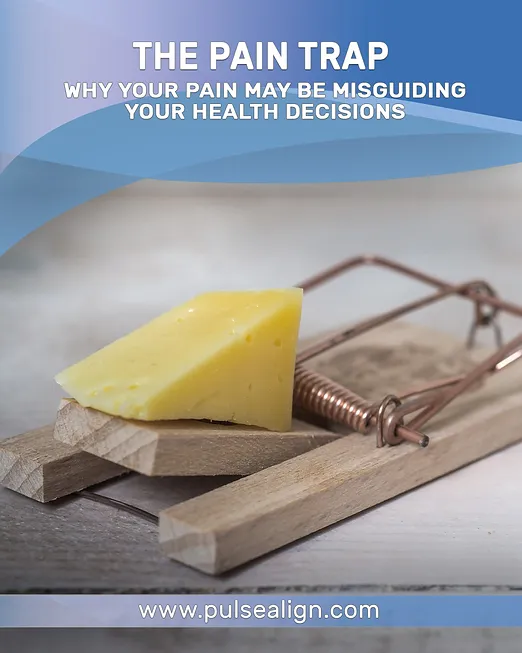Pain is often the body’s final cry for help. Like the searing throb of a decayed tooth or the dull ache of advanced cancer, pain often signals a point of no return in disease progression. But what if pain is misleading us into complacency?
Painless Physical Signs that Precede Pain
Before the onset of pain, there are often telltale signs. Asymmetrical muscle tone, morning stiffness, reduced flexibility, and unexplained fatigue are like whispering voices that precede the shout of pain. These subtle symptoms might hint at health problems that are still in their early, more manageable stages.
A post shared by Pulse Align (@pulsealign)
Symptoms: The First to Disappear
When we begin treatment, pain is often the first symptom to disappear. Imagine filling a cookie jar – the last cookie to enter the jar is the pain. When you begin your treatment, the pain ‘cookie’ is often the first one you take out. But the jar isn’t empty yet. The remaining cookies, representing the underlying issues, still need to be addressed.
Why Do People Stop Treatment Early?
Many patients discontinue treatment as soon as the pain subsides, believing they’ve recovered. Others stop treatment due to financial constraints or because they’re too busy with work or family obligations. Some even put their health on the backburner due to low self-esteem, prioritizing the care of their pets, vehicles, or homes over their personal wellbeing.
The Consequences of Stopping Early
However, ending treatment prematurely can have serious consequences. The disease could relapse, progress further, or even cause complications. In addition, the financial burden of healthcare can increase significantly if a disease progresses to a more severe stage due to incomplete treatment.
Strategies to Avoid the Pain Trap
So, how can we avoid this ‘Pain Trap’? The key is to understand that the absence of pain does not necessarily mean the disease is entirely gone. We must strive to complete our treatment and pay attention to other, more subtle signs of illness.
Conclusion
In short, don’t just remove the pain ‘cookie’ and assume the jar is empty. Make sure you ‘eat all the cookies’ by addressing all underlying health issues. By doing so, you can avoid the ‘Pain Trap’ and ensure a more comprehensive and lasting recovery.
References
- Crombez, G., Eccleston, C., Van Damme, S., Vlaeyen, J.W., & Karoly, P. (2012). Fear-avoidance model of chronic pain: the next generation. The Clinical journal of pain, 28(6), 475–483. https://doi.org/10.1097/AJP.0b013e3182385392
- Van Middelkoop, M., Rubinstein, S. M., Verhagen, A. P., Ostelo, R. W., Koes, B. W., & Van Tulder, M. W. (2010). Exercise therapy for chronic nonspecific low-back pain. Best practice & research Clinical rheumatology, 24(2), 193–204. https://doi.org/10.1016/j.berh.2010.01.002
- Osterberg, L., & Blaschke, T. (2005). Adherence to medication. The New England journal of medicine, 353(5), 487–497. https://doi.org/10.1056/NEJMra050100
- Sabaté E. (2003). Adherence to long-term therapies: evidence for action. World Health Organization. https://www.who.int/chp/knowledge/publications/adherence_full_report.pdf
- Zullig, L. L., Bosworth, H. B., & Jeffreys, A. S. (2012). The role of patient activation in the management of chronic conditions. North Carolina medical journal, 73(5), 385–386. https://www.ncbi.nlm.nih.gov/pmc/articles/PMC4062023/
- Moseley, G.L., & Butler, D.S. (2015). Fifteen Years of Explaining Pain: The Past, Present, and Future. The Journal of Pain, 16(9), 807–813. https://doi.org/10.1016/j.jpain.2015.05.005
- Nahin, R.L. (2015). Estimates of Pain Prevalence and Severity in Adults: United States, 2012. The Journal of Pain, 16(8), 769-780. https://doi.org/10.1016/j.jpain.2015.05.002
- Llewelyn, M.J., Fitzpatrick, J.M., Darwin, E., Tonkin-Crine, S., Gorton, C., Paul, J., Peto, T.E.A., Yardley, L., Hopkins, S., & Walker, A.S. (2017). The antibiotic course has had its day. BMJ (Clinical research ed.), 358, j3418. https://doi.org/10.1136/bmj.j3418
- Cutler, R.L., Fernandez-Llimos, F., Frommer, M., Benrimoj, C., & Garcia-Cardenas, V. (2018). Economic impact of medication non-adherence by disease groups: a systematic review. BMJ Open, 8(1), e016982. https://doi.org/10.1136/bmjopen-2017-016982
- Barello, S., Graffigna, G., & Vegni, E. (2012). Patient engagement as an emerging challenge for healthcare services: mapping the literature. Nursing research and practice, 2012, 905934. https://doi.org/10.1155/2012/905934
#backpain #Lifestyle #naturalhealth
As the visionary CEO of Pulse Align, François is dedicated to transforming the landscape of pain management and posture health. With a deep-rooted passion for innovation and a commitment to excellence, François leads the team in developing cutting-edge solutions that empower individuals to live healthier, pain-free lives. Under his leadership, Pulse Align has become a beacon of hope and support for those navigating postural-related issues and chronic pain. François brings a wealth of experience in neuromodulation and patient management technologies, combining strategic insight with a compassionate approach to address the unique challenges faced by each individual.


